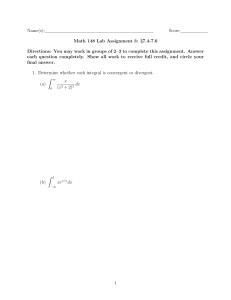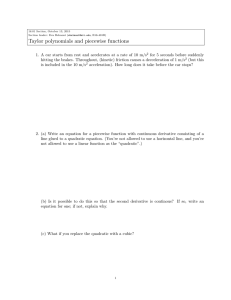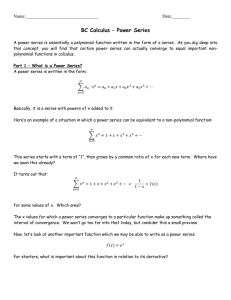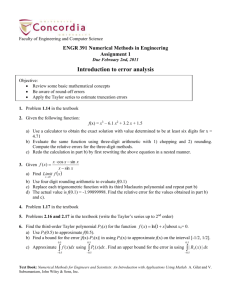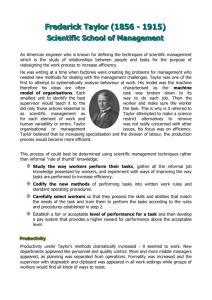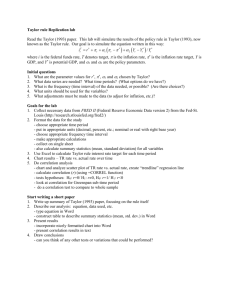Remainder estimation 1. Let f(x) = √ x + 1. Compute the Taylor
advertisement
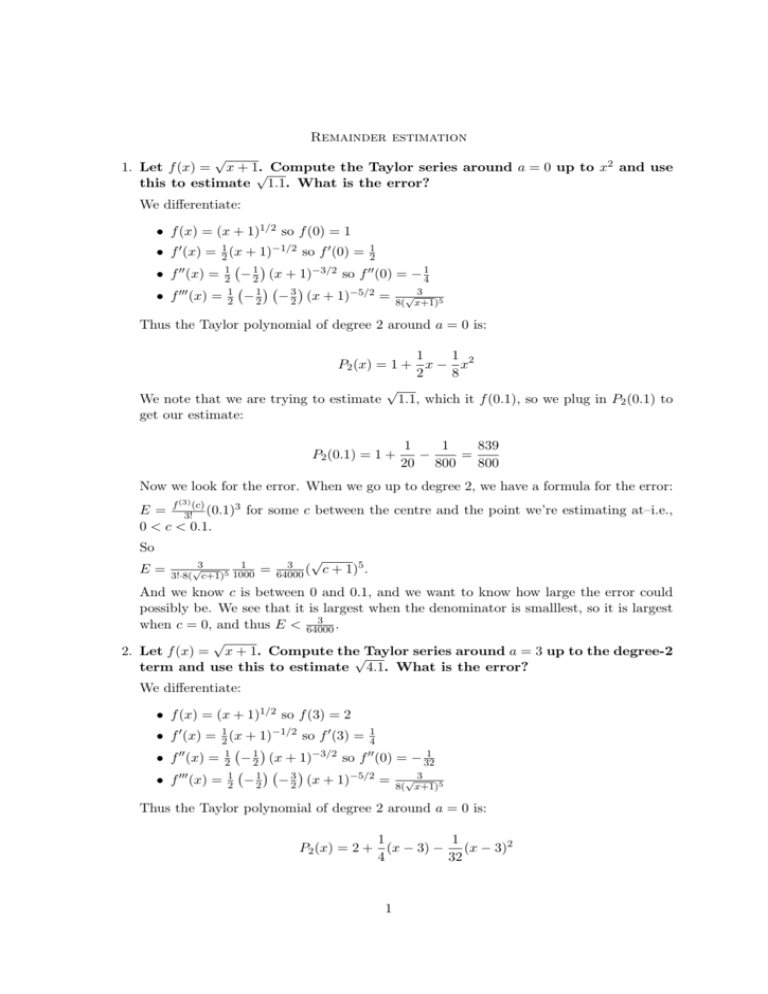
Remainder estimation √ 2 1. Let f (x) = x + 1. √ Compute the Taylor series around a = 0 up to x and use this to estimate 1.1. What is the error? We differentiate: • f (x) = (x + 1)1/2 so f (0) = 1 • f 0 (x) = 12 (x + 1)−1/2 so f 0 (0) = 12 • f 00 (x) = 12 − 21 (x + 1)−3/2 so f 00 (0) = − 14 3 • f 000 (x) = 21 − 12 − 32 (x + 1)−5/2 = 8(√x+1) 5 Thus the Taylor polynomial of degree 2 around a = 0 is: 1 1 P2 (x) = 1 + x − x2 2 8 √ We note that we are trying to estimate 1.1, which it f (0.1), so we plug in P2 (0.1) to get our estimate: P2 (0.1) = 1 + 1 1 839 − = 20 800 800 Now we look for the error. When we go up to degree 2, we have a formula for the error: (3) E = f 3!(c) (0.1)3 for some c between the centre and the point we’re estimating at–i.e., 0 < c < 0.1. So E= 1 √3 3!·8( c+1)5 1000 = √ 3 64000 ( c + 1)5 . And we know c is between 0 and 0.1, and we want to know how large the error could possibly be. We see that it is largest when the denominator is smalllest, so it is largest 3 when c = 0, and thus E < 64000 . √ 2. Let f (x) = x + 1. Compute the√Taylor series around a = 3 up to the degree-2 term and use this to estimate 4.1. What is the error? We differentiate: • f (x) = (x + 1)1/2 so f (3) = 2 • f 0 (x) = 12 (x + 1)−1/2 so f 0 (3) = 14 1 • f 00 (x) = 12 − 21 (x + 1)−3/2 so f 00 (0) = − 32 3 • f 000 (x) = 21 − 12 − 32 (x + 1)−5/2 = 8(√x+1) 5 Thus the Taylor polynomial of degree 2 around a = 0 is: 1 1 P2 (x) = 2 + (x − 3) − (x − 3)2 4 32 1 We note that we are trying to estimate get our estimate: √ P2 (3.1) = 2 + 4.1, which it f (3.1), so we plug in P2 (3.1) to 1 1 6479 − = 40 3200 3200 Now we look for the error. When we go up to degree 2, we have a formula for the error: (3) E = f 3!(c) (3.1 − 3)3 for some c between the centre and the point we’re estimating at–i.e., 3 < c < 3.1. So √ 1 3 E = 3!·8(√3c+1)5 1000 = 64000 ( c + 1)5 . And we know c is between 3 and 3.1, and we want to know how large the error could possibly be. We see that it is largest when the denominator is smalllest, so it is largest 3 when c = 3, and thus E < 128000 . 3. Let f (x) = ln(x + 5) − ln 5. Approximate this by this estimate provided |x| < 0.1? x 5 − x2 50 . What is the error in First, we compute the Taylor series for f around a = 0: f (x) = ln(x + 5) − ln(5), so f (0) = 0. f 0 (x) = 1 x+5 , so f 0 (0) = 15 . 1 1 00 f 00 (x) = − (x+5) 2 , so f (0) = − 25 . f 000 (x) = 2 . (x+5)3 So we see that the given estimate is the degree-2 Taylor series for f , and therefore by (3) Taylor’s theorem, the absolute value of the error for |x| < 0.1 is exactly | f 3!(c) x3 | = |x|3 . 3|c+5|3 And |x| < 0.1 and c between 0 and x, so −0.1 < x < 0.1 and −0.1 < c < 0.1. So to make the error as big as possible, we make the numerator as big as possible, which happens when x = 0.1, and the denominator as small as possible, which happens when (0.1)3 c = −0.1, so the error is, in absolute value, bounded by 3(4.9) 3. 4. Let f (x) = sin(x). Approximate this by x − estimate provided |x| < 0.1? 2 x3 6 . What is the error in this

